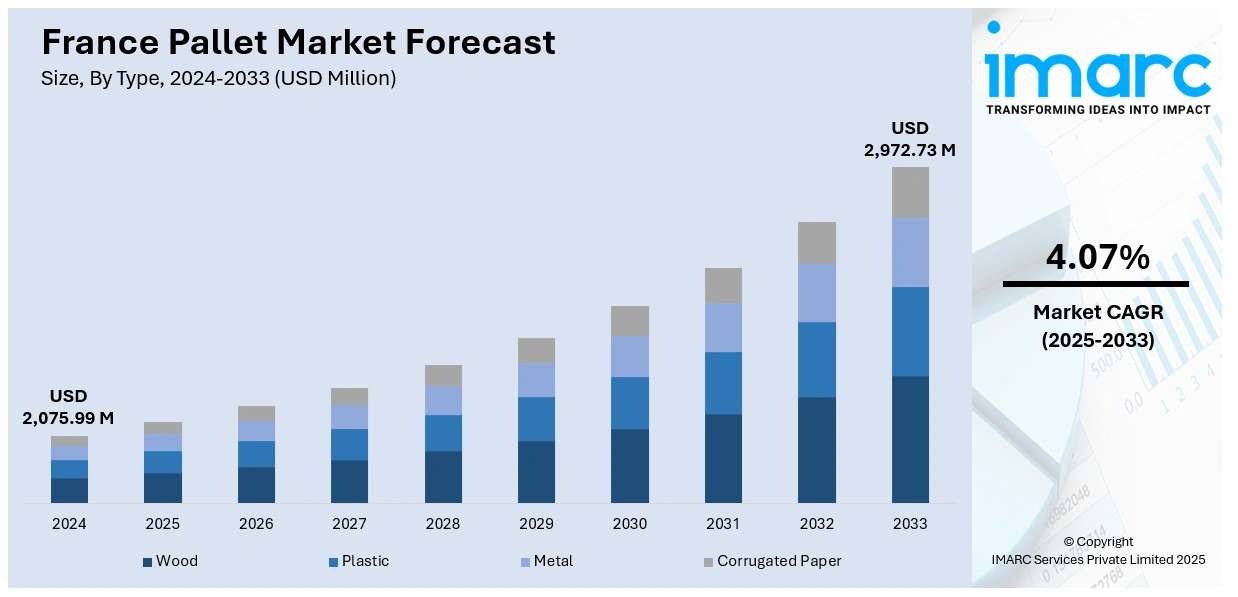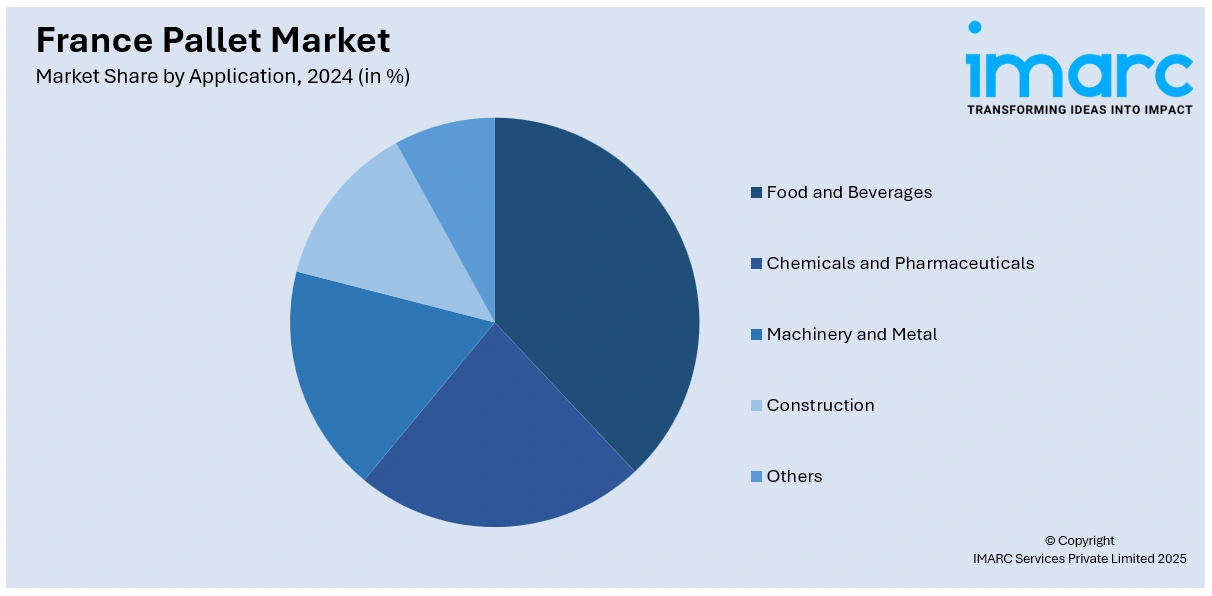
France Pallet Market Size, Share, Trends and Forecast by Type, Application, Structural Design, and Region, 2025-2033
France Pallet Market Overview:
The France pallet market size reached USD 2,075.99 Million in 2024. Looking forward, IMARC Group expects the market to reach USD 2,972.73 Million by 2033, exhibiting a growth rate (CAGR) of 4.07% during 2025-2033. The market is driven by stringent regulations such as the AGEC law, which mandates reusable packaging and waste reduction. It is further propelled by the need for supply chain optimization and cost efficiency through pallet pooling systems. Moreover, growing demand for real-time shipment tracking and condition monitoring is accelerating smart pallet adoption, further augmenting the France pallet market share.
|
Report Attribute
|
Key Statistics
|
|---|---|
|
Base Year
|
2024
|
|
Forecast Years
|
2025-2033
|
|
Historical Years
|
2019-2024
|
| Market Size in 2024 | USD 2,075.99 Million |
| Market Forecast in 2033 | USD 2,972.73 Million |
| Market Growth Rate 2025-2033 | 4.07% |
France Pallet Market Trends:
The Accelerating Shift Towards a Circular and Sustainable Pallet Economy
A dominant trend in the market is the decisive move towards a circular economy, fundamentally moving away from a single-use, disposable model. France's circular economy industry employs 523,900 individuals, which is 1.8% of all employment, contributes €2.8 Trillion (approximately USD 3.26 Trillion) to GDP, or 16.6% of the EU total GDP, and material use of 759.9 million tons, or 11.9% of the EU total. The level of circular material consumption in France is only 11.5%, compared with 19.3% in the EU. The national ambitions are a 30% reduction in resource usage by 2030, 100% recycled plastic by 2025, and a ban on single-use plastic packaging by 2040. These actions will directly impact pallet logistics, which will require the usage of reused and recycled wood. Since France's industrial sector accounts for 20.6% of its GDP and pallets are important for transportation and storage, it will put pressure on pallet manufacturers to adopt reuse, repair, and recycling procedures under the mode of extended producer responsibility in order to attain these objectives. Environmental regulations, such as France’s Anti-Waste for a Circular Economy (AGEC) law, and growing corporate sustainability mandates are compelling businesses to adopt reusable and recyclable pallet solutions. The well-established EPAL pallet pool remains a cornerstone of this system, promoting standardization and efficient return loops. Furthermore, there is a rising demand for pallets made from alternative, sustainable materials beyond traditional wood, including recycled plastic and composite materials, which offer greater durability and hygiene for specific supply chains. This trend is not merely regulatory compliance but a strategic shift, as companies recognize that sustainable pallet pooling systems reduce long-term costs, minimize waste, and enhance green credentials in the eyes of consumers and partners, making circularity a key competitive advantage.

To get more information on this market, Request Sample
Digitalization and Integration of Smart Pallet Technologies
The digitalization and the integration of smart technologies are propelling the France pallet market growth. Businesses are moving beyond viewing pallets as simple wooden platforms and are starting to see them as vital data carriers within the supply chain. The adoption of pallets equipped with IoT sensors, RFID tags, and QR codes is growing. These technologies provide real-time visibility into a pallet’s location, condition (recording shocks, tilt, or temperature variations), and status throughout its journey. This data is invaluable for optimizing logistics operations, improving inventory accuracy, enhancing security against theft or loss, and ensuring the integrity of sensitive cargoes such as pharmaceuticals or high-value goods. This trend towards smart pallets is driven by the broader Industry 4.0 movement, enabling more automated, efficient, and data-driven supply chains. Companies investing in these technologies gain a significant edge in operational control and customer service.
France Pallet Market Segmentation:
IMARC Group provides an analysis of the key trends in each segment of the market, along with forecasts at the country and regional level for 2025-2033. Our report has categorized the market based on type, application, and structural design.
Type Insights:
- Wood
- Plastic
- Metal
- Corrugated Paper
The report has provided a detailed breakup and analysis of the market based on the type. This includes wood, plastic, metal, and corrugated paper.
Application Insights:

- Food and Beverages
- Chemicals and Pharmaceuticals
- Machinery and Metal
- Construction
- Others
A detailed breakup and analysis of the market based on the application has also been provided in the report. This includes food and beverages, chemicals and pharmaceuticals, machinery and metal, construction, and others.
Structural Design Insights:
- Block
- Stringer
- Others
The report has provided a detailed breakup and analysis of the market based on the structural design. This includes block, stringer, and others.
Regional Insights:
- Paris Region
- Auvergne-Rhône-Alpes
- Nouvelle-Aquitaine
- Hauts-de-France
- Occitanie
- Provence Alpes Côte d’Azur
- Grand Est
- Others
The report has also provided a comprehensive analysis of all the major regional markets, which include Paris Region, Auvergne-Rhône-Alpes, Nouvelle-Aquitaine, Hauts-de-France, Occitanie, Provence Alpes Côte d’Azur, Grand Est, and others.
Competitive Landscape:
The market research report has also provided a comprehensive analysis of the competitive landscape. Competitive analysis such as market structure, key player positioning, top winning strategies, competitive dashboard, and company evaluation quadrant has been covered in the report. Also, detailed profiles of all major companies have been provided.
France Pallet Market Report Coverage:
| Report Features | Details |
|---|---|
| Base Year of the Analysis | 2024 |
| Historical Period | 2019-2024 |
| Forecast Period | 2025-2033 |
| Units | Million USD |
| Scope of the Report |
Exploration of Historical Trends and Market Outlook, Industry Catalysts and Challenges, Segment-Wise Historical and Future Market Assessment:
|
| Types Covered | Wood, Plastic, Metal, Corrugated Paper |
| Applications Covered | Food and Beverages, Chemicals and Pharmaceuticals, Machinery and Metal, Construction, Others |
| Structural Designs Covered | Block, Stringer, Others |
| Regions Covered | Paris Region, Auvergne-Rhône-Alpes, Nouvelle-Aquitaine, Hauts-de-France, Occitanie, Provence Alpes Côte d’Azur, Grand Est, Others |
| Customization Scope | 10% Free Customization |
| Post-Sale Analyst Support | 10-12 Weeks |
| Delivery Format | PDF and Excel through Email (We can also provide the editable version of the report in PPT/Word format on special request) |
Key Questions Answered in This Report:
- How has the France pallet market performed so far and how will it perform in the coming years?
- What is the breakup of the France pallet market on the basis of type?
- What is the breakup of the France pallet market on the basis of application?
- What is the breakup of the France pallet market on the basis of structural design?
- What is the breakup of the France pallet market on the basis of region?
- What are the various stages in the value chain of the France pallet market?
- What are the key driving factors and challenges in the France pallet market?
- What is the structure of the France pallet market and who are the key players?
- What is the degree of competition in the France pallet market?
Key Benefits for Stakeholders:
- IMARC’s industry report offers a comprehensive quantitative analysis of various market segments, historical and current market trends, market forecasts, and dynamics of the France pallet market from 2019-2033.
- The research report provides the latest information on the market drivers, challenges, and opportunities in the France pallet market.
- Porter's five forces analysis assist stakeholders in assessing the impact of new entrants, competitive rivalry, supplier power, buyer power, and the threat of substitution. It helps stakeholders to analyze the level of competition within the France pallet industry and its attractiveness.
- Competitive landscape allows stakeholders to understand their competitive environment and provides an insight into the current positions of key players in the market.
Need more help?
- Speak to our experienced analysts for insights on the current market scenarios.
- Include additional segments and countries to customize the report as per your requirement.
- Gain an unparalleled competitive advantage in your domain by understanding how to utilize the report and positively impacting your operations and revenue.
- For further assistance, please connect with our analysts.
 Request Customization
Request Customization
 Speak to an Analyst
Speak to an Analyst
 Request Brochure
Request Brochure
 Inquire Before Buying
Inquire Before Buying




.webp)




.webp)












